Using Language Oriented Programming to Execute Computations on the GPU
- 1. Using Language Oriented Programming to Execute Computations on the GPU Robert Pickering, ALTI
- 2. About the Presenter • Using F# for about 6 years • Oldest F# user outside of Microsoft • Written a book about F# (now in its second edition) • Spend at least 2 years as a professional functional programmer • I have 3 cats Contact me: robert@strangelights.com http://strangelights.com/blog 2
- 3. ALTI • Large French services company • Consulting, engineering and training • Believe in helping clients discover upcoming niches • Already offer F# training and consulting
- 4. What is Language Oriented Programming ? • Creating programs that are an abstract description of the a problem • This description can then either be interpreted, compiled, or analyzed in another way
- 5. LOP & Combinators • F# has two main approaches to Language Oriented Programming: – Reinterpreting the F# syntax though the quotations system – Using combinators create a new syntax … both approaches are very similar
- 6. What is a Combinator? A combinator is a higher-order function that uses only function application and earlier defined combinators to define a result from its arguments. Source: Wikipedia, http://en.wikipedia.org/wiki/Combinatory_Logic
- 7. Combinatory Logic in Computing In computer science, combinatory logic is used as a simplified model of computation, used in computability theory and proof theory. Despite its simplicity, combinatory logic captures many essential features of computation. Source: Wikipedia, http://en.wikipedia.org/wiki/Combinatory_Logic
- 8. Combinator Library "A combinator library offers functions (the combinators) that combine functions together to make bigger functions"[1]. These kinds of libraries are particularly useful for allowing domain-specific programming languages to be easily embedded into a general purpose language by defining a few primitive functions for the given domain. Souce: Wikipedia http://en.wikipedia.org/wiki/Combinator_library [1] “A History of Haskell” Hudak, Hughes, Peyton Jones, Wadler
- 9. History of Haskell: Combinator Libraries What is a combinator library? The reader will search in vain for a definition of this heavily used term, but the key idea is this: a combinator library offers functions (the combinators) that combine functions together to make bigger functions.
- 10. History of Haskell: Combinator Libraries What is a combinator library? The reader will search in vain for a definition of this heavily used term, but the key idea is this: a combinator library offers functions (the combinators) that combine functions together to make bigger functions.
- 11. History of Haskell: Combinator Libraries Another productive way to think of a combinator library is as a domain-specific language (DSL) for describing values of a particular type.
- 12. What is a Domain Specific Language? A programming language tailored for a particular application domain, which captures precisely the semantics of the application domain -- no more, no less. A DSL allows one to develop software for a particular application domain quickly, and effectively, yielding programs that are easy to understand, reason about, and maintain. Hudak
- 13. Combinators vs DSLs • Combinartor libraries are a special case of DSLs – Sometimes called DSELs (Domain Specific Embed languages) • DSELs have several advantages: ― Inherit non-domain-specific parts of the design. ― Inherit compilers and tools. ― Uniform “look and feel” across many DSLs ― DSLs integrated with full programming language, and with each other. • DSELs one disadvantage: ― Constrained by host language syntax and type system
- 14. What Makes F# a Suitable for DSLs ? • Union Types / Active Patterns – type Option<'a> = Some x | None • Lambda functions – fun x -> x + 1 • Define and redefine operators – let (++) x = x + 1 • Define custom numeric literals – let x : Expression = 1.0N
- 15. Union Types – The Option Type // The pre-defined option type type Option<'a> = | Some of 'a | None // constructing options let someValue = Some 1 let noValue = None // pattern matching over options let convert value = match value with | Some x -> Printf.sprintf "Value: %i" x | None -> "No value"
- 16. Union Types - Trees // a binary tree definition type BinaryTree<'a> = | Node of BinaryTree<'a> * BinaryTree<'a> | Leaf of 'a // walk the tree collection values let rec collectValues acc tree = match tree with | Node(ltree, rtree) -> // recursively walk the left tree let acc = collectValues acc ltree // recursively walk the right tree collectValues acc rtree | Leaf value -> value :: acc // add value to accumulator
- 17. Using the Tree // define a tree let tree = Node( Node(Leaf 1, Leaf 2), Node(Leaf 3, Leaf 4)) // recover all values from the leaves let values = collectValues [] tree
- 18. Union Types Union types play a key role in language oriented programming, as they allow the user to easily define a tree that will form the abstract syntax tree of the language
- 19. Active Patterns // definition of the active pattern let (|Bool|Int|Float|String|) input = // attempt to parse a bool let sucess, res = Boolean.TryParse input if sucess then Bool(res) else // attempt to parse an int let sucess, res = Int32.TryParse input if sucess then Int(res) else // attempt to parse a float (Double) let sucess, res = Double.TryParse input if sucess then Float(res) else String(input)
- 20. Active Patterns // function to print the results by pattern // matching over the active pattern let printInputWithType input = match input with | Bool b -> printfn "Boolean: %b" b | Int i -> printfn "Integer: %i" i | Float f -> printfn "Floating point: %f" f | String s -> printfn "String: %s" s // print the results printInputWithType "true" printInputWithType "12"
- 21. Active Patterns Active patterns play a supporting role in language oriented programming in F#. They allow the programmer to create abstractions of complex operations on the abstract syntax tree
- 22. Lambda Functions fun () -> lovin'()
- 23. Lambda Functions Lambda functions are important for language oriented programming. They allow the users of the language to embed actions within other language elements
- 24. Custom Operators let (++) x = x + 1
- 25. Custom Operators Custom operators play a supporting role in language oriented programming. They allow the language designer to have a more flexible syntax.
- 26. Custom Numeric Literals type Expression = | Constant of int module NumericLiteralN = let FromZero() = Constant 0 let FromOne() = Constant 1 let FromInt32 = Constant let expr = 1N
- 27. Custom Numeric Literals Numeric literals play a supporting role in language oriented programming. They allow numeric literals be treated in a more natural within an embedded language
- 28. The Anatomy of a DSL type Expression = Syntax Tree | Add of Expression * Expression | Subtract of Expression * Expression | Multiply of Expression * Expression | Constant of int Combinators | Parameter of string with static member (+) (x, y) = Add(x, y) static member (-) (x, y) = Subtract(x, y) static member (*) (x, y) = Multiply(x, y) module NumericLiteralN = let FromZero() = Constant 0 let FromOne() = Constant 1 let FromInt32 = Constant let param = Parameter
- 29. The Anatomy of a DSL let expr = (1N + 2N) * (5N - 2N) val expr : Expression = Multiply (Add (Constant 1,Constant 2), Subtract (Constant 5,Constant 2))
- 30. The Anatomy of a DSL • Expressions now have an abstract tree like representation: ― Multiply ― Add ― Constant 1 ― Constant 2 ― Subtract ― Constant 5 ― Constant 2 • This can then be evaluated • Or we can preform more advanced analysis
- 31. The Anatomy of a DSL let evaluateExpression parameters = let rec innerEval tree = match tree with | Multiply (x, y) -> innerEval x * innerEval y | Add (x, y) -> innerEval x + innerEval y | Subtract (x, y) -> innerEval x - innerEval y | Constant value -> value | Parameter key -> Map.find key parameters innerEval let expr = (1N + 2N) * (5N - 2N) evaluateExpression Map.empty expr
- 32. The Anatomy of a DSL
- 33. The Anatomy of a DSL let rec simplifyExpression exp = let simpIfPoss op exp1 exp2 = let exp' = op (simplifyExpression exp1, simplifyExpression exp2) if exp' = exp then exp' else simplifyExpression exp' match exp with | Multiply(Constant 0, Constant _) -> Constant 0 | Multiply(Constant _, Constant 0) -> Constant 0 | Multiply(Constant n1, Constant n2) -> Constant (n1 * n2) | Add(Constant n1, Constant n2) -> Constant (n1 + n2) | Subtract(Constant n1, Constant n2) -> Constant (n1 - n2) | Multiply(exp1, exp2) -> simpIfPoss Multiply exp1 exp2 | Add(exp1, exp2) -> simpIfPoss Add exp1 exp2 | Subtract(exp1, exp2) -> simpIfPoss Add exp1 exp2 | Constant _ | Parameter _ -> exp
- 34. The Anatomy of a DSL
- 35. Quotations let quotation = <@ (1 + 2) * (5 - 2) @> val quotation : Quotations.Expr<int> = Call (None, Int32 op_Multiply[Int32,Int32,Int32](Int32, Int32), [Call (None, Int32 op_Addition[Int32,Int32,Int32](Int32, Int32), [Value (1), Value (2)]), Call (None, Int32 op_Subtraction[Int32,Int32,Int32](Int32, Int32), [Value (5), Value (2)])])
- 36. Quotations • Allow you to grab a tree structure that represents a piece of F# code • This tree structure can then be: – Interpreted – Compiled – Converted to instructions understood by another system or runtime
- 37. Microsoft Accelerator • A project from MRS, now available on Microsoft Connect [1] • Automatically parallelize code for execution on the GPU or x64 multicore • Implemented as an unmanaged library with .NET wrapper [1] http://connect.microsoft.com/acceleratorv2
- 38. Microsoft Accelerator • Based on “Parallel Array” • You define a set of operations to process the content of the array • The Accelerator runtime will then process the operations in parallel
- 39. Microsoft Accelerator User Program – Define Operations Accelerator Input data Accelerated Program Input data DX9Target X64Target
- 40. Microsoft Accelerator – Code! let nums = [| 6; 1; 5; 5; 3 |] let input = new FloatParallelArray(nums); let sum = ParallelArrays.Shift(input, 1) + input + ParallelArrays.Shift(input, -1); let output = sum / 3.0f; let target = new DX9Target(); let res = target.ToArray1D(output);
- 41. Game of Life
- 42. Game of Life • Green - When an existing cell (green in the middle) has three or two neighbours it survives to the next round • Red - When an existing cell has less than two neighbours it dies, because it is lonely (first red case), when it has more than three neighbours it dies of overcrowding (second red case) • Blue - Finally, a new cell is born in an empty grid location if there are exactly three neighbours .
- 43. The implementation 1 1 1 1 initial rotation 1 Sum of all etc. ... neighbours
- 44. Game of Life CPU GPU
- 45. Game of Life /// Evaluate next generation of the life game state let nextGeneration (grid: Matrix<float32>) = // Shift in each direction, to count the neighbours let sum = shiftAndSum grid offsets // Check to see if we're born or remain alive (sum =. threeAlive) ||. ((sum =. twoAlive) &&. grid) CPU GPU
- 46. Game of Life /// Evaluate next generation of the life game state [<ReflectedDefinition>] let nextGeneration (grid: Matrix<float32>) = // Shift in each direction, to count the neighbours let sum = shiftAndSum grid offsets // Check to see if we're born or remain alive (sum =. threeAlive) ||. ((sum =. twoAlive) &&. grid) CPU GPU
- 47. Game of life in F# with Microsoft Accelerator DEMO
- 48. Thanks! • A big thanks to Tomáš Petříček! • More info on his blog: – http://tomasp.net/articles/accelerator-intro.aspx
- 49. Books
- 50. Shameless Plug! • Robert Pickering’s Beginning F# Workshop: – Thursday 9th Sept – 10th September 2010 http://skillsmatter.com/course/open-source- dot-net/robert-pickerings-beginning-f-workshop








![Combinator Library
"A combinator library offers functions (the
combinators) that combine functions together to make
bigger functions"[1]. These kinds of libraries are
particularly useful for allowing domain-specific
programming languages to be easily embedded into a
general purpose language by defining a few primitive
functions for the given domain.
Souce: Wikipedia http://en.wikipedia.org/wiki/Combinator_library
[1] “A History of Haskell” Hudak, Hughes, Peyton Jones, Wadler](https://image.slidesharecdn.com/robertpickering11-05-10-100512040423-phpapp02/85/Using-Language-Oriented-Programming-to-Execute-Computations-on-the-GPU-8-320.jpg)



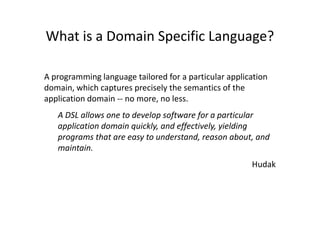
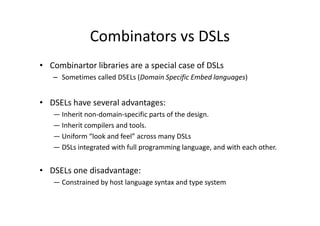
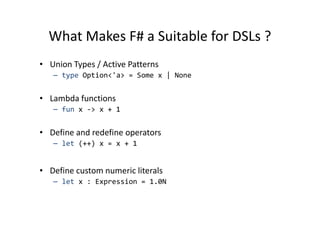
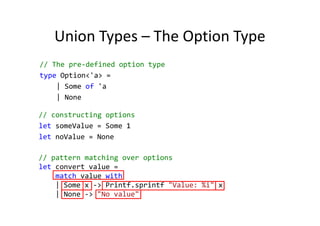

![Using the Tree
// define a tree
let tree =
Node(
Node(Leaf 1, Leaf 2),
Node(Leaf 3, Leaf 4))
// recover all values from the leaves
let values = collectValues [] tree](https://image.slidesharecdn.com/robertpickering11-05-10-100512040423-phpapp02/85/Using-Language-Oriented-Programming-to-Execute-Computations-on-the-GPU-17-320.jpg)





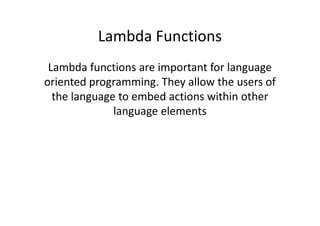



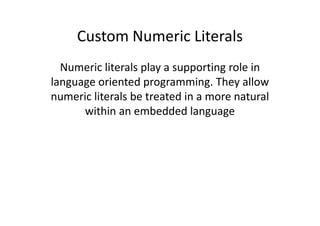







,
[Call (None, Int32 op_Addition[Int32,Int32,Int32](Int32, Int32),
[Value (1), Value (2)]),
Call (None, Int32 op_Subtraction[Int32,Int32,Int32](Int32, Int32),
[Value (5), Value (2)])])](https://image.slidesharecdn.com/robertpickering11-05-10-100512040423-phpapp02/85/Using-Language-Oriented-Programming-to-Execute-Computations-on-the-GPU-35-320.jpg)

![Microsoft Accelerator
• A project from MRS, now available on
Microsoft Connect [1]
• Automatically parallelize code for execution
on the GPU or x64 multicore
• Implemented as an unmanaged library with
.NET wrapper
[1] http://connect.microsoft.com/acceleratorv2](https://image.slidesharecdn.com/robertpickering11-05-10-100512040423-phpapp02/85/Using-Language-Oriented-Programming-to-Execute-Computations-on-the-GPU-37-320.jpg)
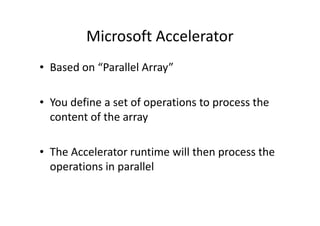
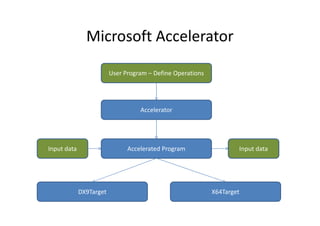
![Microsoft Accelerator – Code!
let nums = [| 6; 1; 5; 5; 3 |]
let input = new FloatParallelArray(nums);
let sum = ParallelArrays.Shift(input, 1) + input +
ParallelArrays.Shift(input, -1);
let output = sum / 3.0f;
let target = new DX9Target();
let res = target.ToArray1D(output);](https://image.slidesharecdn.com/robertpickering11-05-10-100512040423-phpapp02/85/Using-Language-Oriented-Programming-to-Execute-Computations-on-the-GPU-40-320.jpg)

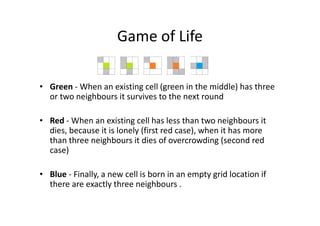
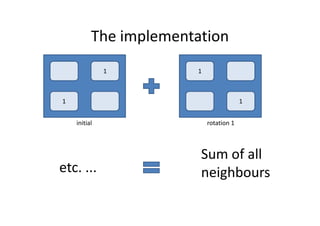


![Game of Life
/// Evaluate next generation of the life game state
[<ReflectedDefinition>]
let nextGeneration (grid: Matrix<float32>) =
// Shift in each direction, to count the neighbours
let sum = shiftAndSum grid offsets
// Check to see if we're born or remain alive
(sum =. threeAlive) ||. ((sum =. twoAlive) &&. grid)
CPU GPU](https://image.slidesharecdn.com/robertpickering11-05-10-100512040423-phpapp02/85/Using-Language-Oriented-Programming-to-Execute-Computations-on-the-GPU-46-320.jpg)



